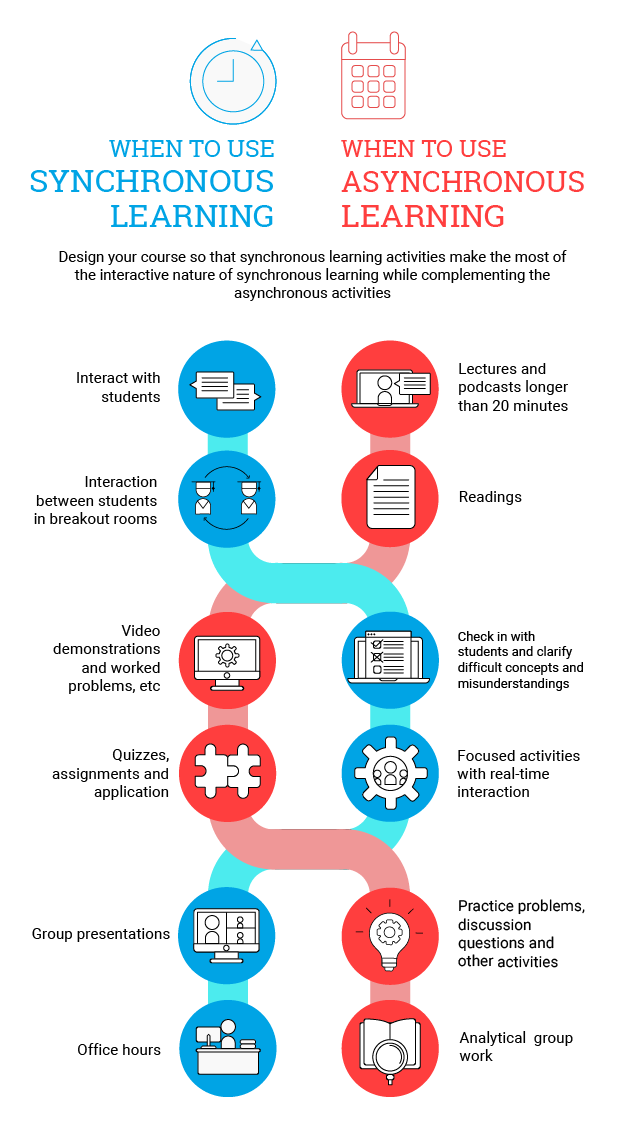What is Synchronous Learning?
Helpful Matrices: Digital Learning Formats – Characteristics and Components PDF and NIC Delivery Formats – PDF
What is Synchronous Learning? Course has required real-time, live online interactions and regular class contact time scheduled between the instructor and students most often using a desktop video/web conferencing platform and other digital learning tools. Course is characterized by regular and substantive digital interactions between course instructor and students which occur both in the live classes and through digital content and activities. Other characteristics include:
-
- Teaching and learning activities occur in digital formats using a variety of learning technologies and digital resources.
- Class focuses on concurrent, collective, and collaborative learning amongst students.
- Defined deadlines for completion of assignments and other course related activities.
- Students may have to intermittently work in groups with other students or undertake collaborative activities, but these can be done both in live online sessions and offline through other digital tools at times that work well for all group members.
- Mid-terms, tests, and quizzes including any final exams will take place digitally via a variety of formats.
- If a final exam is scheduled for the course, the exam will take place digitally on a certain day/time according to the institutional exam schedule.
- There may be optional live, online office hours.
Resources
Synchronous and Asynchronous Learning: Two Basic Formats of Learning in an Online Environment | Centre for Teaching and Learning, Concordia University
- Excellent website outlining the differences between the two formats for teaching and learning with easy to follow charts.
(The Right) Learning Modalities to Delivery Digital Learning: Part 4 (Synchronous) | Article by Patti Shank from eLearning Industry
- shares some tips on how to make synchronous learning work well (immediacy and social interaction, etc) and where the limitations and challenges are with synchronous
Zoom Boom: Synchronous instruction is trending, but experts say a more intentional mix of live and asynchronous classwork is necessary for future remote terms | Article from Inside Higher Ed
- Written near the beginning of the pandemic, this article outlines some of the limitations and challenges with live synchronous classes and what instructors may need to consider going forward.
Use of cameras in Video Conferencing Calls – Practices and Privacy
Different viewpoints. Just something to think about. You might want to consider a little chat with students in your class about using the background blur in BlueJeans to provide more privacy or having them understand why you want their video cameras on – just some thoughts.
- Cameras On or Off? Depends! What We’ve Learned from Students about Teaching and Learning on Zoom | Faculty Focus Article (Sept 2022)
- Cameras Be Damned | LinkedIn Article by Karen Costa (May 2020)
- About that Webcam Obsession You’re Having… | Article Maha Bali (June 2020)
Technical and Management Tips for Web Conferencing: NIC PDF
Low Bandwidth or Limited Connectivity: Creating a More Accessible Course for Learners: NIC PDF
- NIC handout summarizing a key article on connectivity and the issues around live classes and alternatives
From Concordia University, this chart of when to use synchronous vs. asynchronous learning.
Synchronous and Asynchronous Learning by Centre for Teaching and Learning, Concordia University CC BY-SA 4.0

